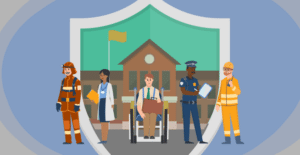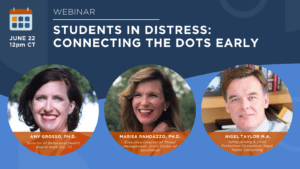Listen to this blog
8 minutes
Multi-Tiered System of Supports (MTSS) is a universal framework that helps schools identify and assist students who are struggling. While MTSS primarily focuses on academic achievement and school attendance, districts can also use this framework to recognize and assist students facing emotional health concerns. Today’s students are experiencing a child mental health crisis, compounded by social issues like a global pandemic and racially-motivated violence. With so many stressors increasing the demand for child mental health services, schools may benefit from applying the MTSS model to triage emotional health concerns and direct mental health resources where they will have the greatest impact on students.
How Can Schools Use MTSS?
MTSS increases support based on each student’s needs, recognizing that behavioral, social, and emotional challenges can impact their academic success. Key members across the school community—like teachers, counselors, psychologists, nurses, and guardians—work together throughout the framework to identify struggling students and develop plans to support them.
School staff and teachers are trained in MTSS, including how to identify students in need and provide the right level of support. While most students thrive with universal supports, such as a school-wide social-emotional learning curriculum, some may need more individualized attention. MTSS allows schools to categorize students by their emotional health needs, allowing overworked counselors, social workers, and school psychologists to focus their efforts where it counts.
MTSS groups students into three tiers:
- Tier 1 is the universal foundation for academics and behavior for all students. Most students succeed with the support provided in this tier. Tier 1 supports may include motivational speakers for school-wide assemblies, career or college fairs, and school-wide anti-bullying programs.
- Tier 2 is targeted at students who need some additional support. This may include things like small group instruction, social skills groups, and formalized mentorship programs like Check & Connect.
- Tier 3 includes intensive, individualized support services, such as one-on-one tutoring or counseling sessions. These services are targeted at the most vulnerable 5% of students.
Students are monitored throughout the year using data such as attendance and academic performance. Additionally, students may move between these tiers fluidly as their needs and stressors change. For example, some students may only require short-term individual support to get through a stressful situation (like a divorce or death in the family) and are able to return to a lower tier after the stressor has passed.
How Can Schools Apply the MTSS Framework to Students in Need of Emotional Support?
School staff are typically the first to notice when a student is in emotional distress—just like they’re the first to notice when a student’s academic performance declines. This empowers schools to reduce the child’s exposure to harm and give them the support they need to cope and heal.
When we can identify the very early signs of a student needing support, we can more effectively provide the right supports to prevent situations from escalating into long-term mental or physical health issues, self-harm, or targeted acts of violence.
MTSS can be applied to support students’ emotional health by:
- training staff to recognize warning signs
- focusing on understanding the root cause of a student’s challenges
- bringing together key members of the school community to support students
- offering tiered support based on each unique child’s needs
What is an Example of MTSS for Student Wellbeing?
When a tornado hit Joplin School District in Missouri, it destroyed 19 school buildings and countless houses and businesses. Over 160 people, including a senior high school student within the district, were killed.
Dr. CJ Huff, former superintendent for the district, is credited for bringing his district and community together after this devastating crisis. “From a leadership standpoint, we have to take into account the emotional state of the people that we’re leading,” he said on a Raptor school safety webinar.
Here’s what a multi-tiered response, like an MTSS framework, could look like in this situation.
- All students start on Tier 1. Counselors and psychologists are available to students, guardians, and staff. The district also contacts students and guardians to ask how they are doing and if they were affected by the storm. School staff continue to monitor students for signs of distress.
- Students that have experienced impacts and/or are suffering from mental health challenges, like anxiety or depression, move to Tier 2. The school and appropriate community members create a support plan for the individual student. For example, the plan may include collecting food, clothing, or household items for a student who lost his home. The school community continues to monitor and track the student for additional signs of distress or escalation.
- Students in extreme distress move to Tier 3 for intensive support. This plan typically involves regular one-on-one therapy or counseling sessions. The school may bring in a grief counselor, for example, each week to meet with students who have lost a loved one. Continuously screening these students is imperative to prevent escalation and issues such as isolation, suicide ideation, self-harm, or acts of violence.
How Can Schools Better Monitor and Support Students' Emotional Health and Wellbeing?
Many schools rely on manual processes to monitor and track students’ wellbeing. Staff may jot down their concerns in their notebooks or share concerns with a colleague. Likewise, parents or guardians may share information with the front office secretary and rely on word-of-mouth to share information with other staff. As a result, those low-level concerns don’t get addressed and the student’s problems grow. By now, the student is so far down the wrong path that it will require considerable time, effort, and resources to get them back on track.
Alternatively, when staff have a central, secure place to note those concerns, you can see a holistic view of the student and intervene at a very early stage. Likewise, you can use software technology to help you identify trends and use MTSS to address them with level 1 or level 2 programs.
“It’s encouraging to see the use of technology to help bridge gaps in information and awareness for our students,” said Dewey G. Cornell, Ph.D, forensic clinical psychologist and Professor of Education in the School of Education and Human Development at the University of Virginia.
“We cannot wait until a small problem has grown into a crisis before we take action,” said Cornell. “With a comprehensive, wrap-around approach, our school counselors, nurses, psychologists, and social workers are better equipped to…truly [take a] proactive approach to student safety and well-being.”
To learn more about early intervention and digital student chronologies, download our free guide here.
Related Resources
Guide to K-12 Student Wellbeing
Strategies to Recognize, Document, and Support Students in Distress
Download now

Listen to this blog
8 minutes







